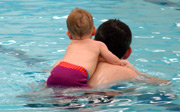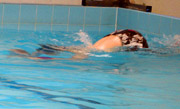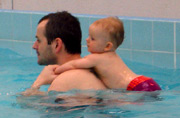

Lots of new baby swimming techniques and routines today. We had a 2 week break so it's catch up time.

The first two new routines involved the glide swim. In the first one you do the glide swim with a release (meaning you let go of the baby at the end). A second person is waiting holding a hula hoop, they are standing at the point where you release your baby. You release your baby and they go through the hoop while you swim around the side of it. The second person retrieves the baby and hands the baby back to you as soon as you surface and find your feet.
If the glide swim is new to you follow this link for the first baby swimming article introducing the glide swim. This routine went well for us, as a left hander I swam around the right of the hoop and moved my hands to the left a little to release Amélie through the hoop. It took a few seconds for me to be ready to have her passed back to me though, I'm not used to going from horizontal to standing in such shallow water.
In the second routine you do the glide swim with a release, the second person catches the baby but there is no hoop. When you find your feet and retrieve your baby from the second person you go straight into side holding swim position and towards the side of the pool for a reaching hold on. Our pool only has a bar on one side so we started this routine from the opposite side of the pool.

The embarrassing picture is of me doing the second of these routines. It catches me just after I've said 'Amélie ... Ready ... Go', I'm under the water with Amélie about to push off from the side with my legs. The pool is so shallow you can see my rear sticking up out of the water, Amélie is held out in front of me under the water and you can see her pinkish trunks.
I was surprised Amélie was happy to do both these routines, and even held on well for the reaching hold on. Now I can get her to hold on and just leave her there for half a minute or so. I'm surprised because these are such big underwater swims, half the width of the pool at least and at a pretty fast pace. Amélie is laughing and smiling much more often, and sometimes squeals with delight and excitement.
The next routine was called 'Monkey, Monkey, Monkey'. You get your baby to hold onto the side, and the idea is for them to move along the side. We were told that in time they would shuffle along on their own so fast that it's hard to keep up with them. For now we had to help them by putting our hands on theirs and moving their hands for them. While doing this we are singing 'Monkey, Monkey, Monkey', it's more of a slow chant than a song though. We do it to the tune kids use to tease other kids 'nah, nah, nah nah, nah', and I think it's the same as ring a ring a roses. I guess the tune doesn't matter though.
First we moved to the left a couple of feet, and then we moved to the right. To move to the left you take their left hand off the bar/side using your left hand and place it back on the bar/side a few inches to the left. You then pick up their right hand with your right hand and place it to the left a few inches. Repeating this a few times until you have moved a few feet, and then reverse the procedure to move back to the right.
I found it hard to lift my baby's hand off the bar by just placing my hand over and above hers, so used my pinkie and the finger next to it to reach over the back of her wrist and rest on the front of her wrist. When I pulled her hand off the bar with mine I used gentle pressure on her wrist with those fingers to help lift her hand off.

The next brand new routine was Horsey Horsey. Your baby is on your back with their arms over your shoulders, and you are holding their hands at the front. To get into this position you have your baby facing you, cross one arm over the other and hold their hands. So you are holding their left hand in your left hand and their left hand in your right hand. You may need to support them on your knee to get into this position.
This is where you really need a diagram because it's hard to explain. I will add this to our diagram section but at the time of writing this article I've not done the diagram, but do keep checking the diagram section because I'm adding to it all of the time and the diagram may be there by the time you read this. The best way of describing what you do next is like putting a coat on. The way you swing the coat around the back of your body before you put your arm into it. You gently swing your baby around until they are on your back. If you start with your right arm over the top of your left you will be swinging to the left, if you start with your left on top you will be swinging to the right. You will end up with your baby on your back, as described above and shown in the pictures.

We proceeded to walk around in a circle with our babies on our backs singing a song. Everyone seemed to know the song but I didn't, it went something like this.
Horsey, horsey don't you stop
just let your feet go clippety clop,
the tail goes swish
and the wheels go round,
giddy up, we're homeward bound.
When we got to 'giddy up' we stood up a little higher and then back down again for the next verse. To get your baby off your back simply reverse the procedure to get them on. I say 'simply', my explanation wasn't exactly simple, but I'm sure you get the idea.
Next up was chase the fish, only we used a ball instead of a fish. Not much explanation needed, you throw the ball and chase it in side holding swim position.
Then we did another new routine using the square float. This float is square, a couple of inches thick, and about as wide as the length of an average 9 month old baby. We all sat our babies on the float and they had to try and stay seated while the float was wobbled about.
Again I can't remember what we sang, something about wobbling like a jelly. Eventually the wobble was such that the babies fell off (this was an intentional part of the routine) and were caught by the parent. The float was red so we sang about red jelly, after one round of the routine the float was turned over. The other side was blue so we sang about blue jelly and did the routine all over again.
Everything had gone well so far but Amélie found this hard. She was leaning forward and trying to slide off the float right from the start, instead of waiting for the big wobble to unseat her. I helped her the best I could and tried to encourage her to try and keep on but I don't think she got the idea that she was supposed to try and stay on. She looked to be having fun though anyway.
The next routine all of the babies seemed to enjoy most of all. The instructor stood in the middle of the pool with the parents and babies standing around her in a big circle. We held our babies in side holding swim position and swum towards the instructor so all the babies almost met in the middle of the pool next to the instructor. When we got to the instructor we lifted our babies in the air and shouted 'Hurray' (I'm passed being embarrassed by anything now). We then turned and swam back to our original positions in side holding swim position.
We did 3 or 4 sets of this, and for the last one we did it extra quickly. It was a real winner with the babies and the other parents seemed to enjoy it also. I'm sure there was a song to go with it, but we covered so much new material today I couldn't absorb everything. I'll elaborate in subsequent articles when I've had more experience.

Last up was back floating to twinkle twinkle little star. Woggles were handed out, which are long bendy foam rods. The picture isn't great, but you wrap the woggle around your back and hold each side under each arm. Your baby is placed with their backs on your chest and you walk backward. The woggle really helps support the parent, it's much less hard work then the regular back to chest back floating.
As you can see, Amélie didn't want to play ball and was constantly struggling to turn around. After this the lesson was over. Even though I've written this right after the lesson it's not as thorough as I'd have liked, so I hope to fill in any gaps in future articles.
I'm aware this article is long, but before I close I wanted to get across how much fun all the babies had, and how much they have all developed over the 25 lessons. Amélie will be 9 months old next week and has no fear of water. She will follow instructions and is comfortable with going underwater multiple times each lesson, with no goggles, and not even coughing or gasping when she surfaces.
I hope these articles are of help, perhaps you don't have baby swimming lessons in your area or perhaps you have them but not at a convenient time. We would recommend you join a program if at all possible. We use a company called Waterbabies who have many branches in the UK, and have found them very good although we are in no way affiliated with them.
Another article next week, and until then happy swimming